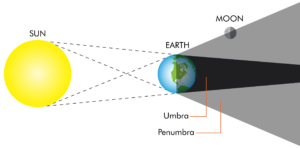
By Madison Mooney
Cowritten with Hailey Osborn and Victoria Girgis, Lowell Educators
On July 4-5, the Moon will turn slightly darker than usual as it moves into the outermost part of Earth’s shadow. This subtle yet significant astronomical event will occur during the full Buck Moon, named for the new antlers that begin to grow from the foreheads of male deer in early July. It will be visible in South/West Europe, much of Africa, much of North America, South America, Pacific, Atlantic, Indian Ocean, and Antarctica. You might just miss this eclipse if you don’t know what to look for, so read on!
What is a penumbral lunar eclipse?
For a penumbral lunar eclipse to occur, the Sun, Moon, and Earth must be imperfectly aligned, and the Moon must be in its full phase. This type of eclipse is difficult to tell apart from a regular full Moon because of its subtlety. During a partial or total lunar eclipse, the Moon moves into the darkest part of the Earth’s shadow (called the umbra). This creates a striking visual effect that is easy to spot. During a penumbral lunar eclipse, the Moon moves into a lighter, more diffused part of the Earth’s shadow called the penumbra. This causes the sunlight reflecting on the Moon’s surface to appear only slightly darker, rather than turning the deep shade of reddish-orange that is typically associated with lunar eclipses. Approximately 35% of all lunar eclipses are penumbral, but you seldom hear about them because of their subtlety.

The Moon’s position in the Earth’s shadow during a penumbral eclipse (not to scale).
How can I view the penumbral lunar eclipse?
To view any type of lunar eclipse, all you need is a clear view of the Moon and sky, the proper clothing for the weather, a comfortable chair, and a good idea of what you’re watching for. If you want to use equipment, a small telescope or a pair of binoculars would be well-suited to seeing the subtle changes in color on the Moon’s surface as the Earth’s shadow moves across it. Here in Flagstaff, Arizona, the eclipse will begin on July 4 at 8:07 pm AZ/PT. You can check to see what time the eclipse will occur in your timezone with this lunar eclipse map here.
You can also join us on July 4 at 8 pm AZ/PT for a live stream of the penumbral eclipse, as well as an Interactive Stargazing session from the Giovale Open Deck Observatory!